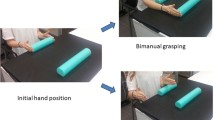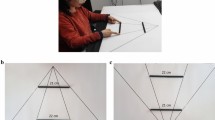Abstract
Recent literature has established a directional influence of irrelevant numerical magnitude on actions performed toward neutral objects. For example, fingers’ aperture during grasping is larger when associated with large compared with small numerical digits. This interaction between symbolic magnitude and visuomotor control has been attributed to the planning stage of the action prior to motor execution. However, this assumption has not been directly tested. In two experiments, we tested whether the effects of numerical magnitude on grasping derive from action planning or from action execution. Participants were asked to grasp an object following a short visual (Experiment 1) or auditory (Experiment 2) presentation of small (1/2) or large (8/9) digits. Grasping was performed under either closed-loop (CL) or open-loop (OL) visuomotor control, for which online vision was prevented during action execution. Digit magnitude affected grip apertures in the CL condition, when online vision was allowed. However, magnitude had no effects on grip aperture in the OL condition. This pattern of results strongly suggests that the processing of numerical magnitude originates from interactions between numerical magnitude and real object size during online motor execution. Unlike previously assumed, the findings also suggest that the effect of magnitude on visuomotor control is not likely to be attributed to the motor planning stage prior to action initiation.



Similar content being viewed by others
References
Alards-Tomalin, D., Walker, A. C., Shaw, J. D. M., & Leboe-McGowan, L. C. (2015). Is 9 louder than 1? Audiovisual cross-modal interactions between number magnitude and judged sound loudness. Acta Psychologica, 160, 95–103.
Andres, M., Ostry, D. J., Nicol, F., & Paus, T. (2008). Time course of number magnitude interference during grasping. Cortex; a journal devoted to the study of the nervous system and behavior, 44(4), 414–419.
Badets, A., Andres, M., Di Luca, S., & Pesenti, M. (2007). Number magnitude potentiates action judgements. Experimental Brain Research, 180(3), 525–534.
Badets, A., & Pesenti, M. (2011). Finger-number interaction. Experimental Psychology, 58(4), 287–292.
Binetti, N., Hagura, N., Fadipe, C., Tomassini, A., Walsh, V., & Bestmann, S. (2015). Binding space and time through action. Proceedings of the Royal Society of London B: Biological Sciences, 282(1805), 20150381.
Cant, J. S., Westwood, D. A., Valyear, K. F., & Goodale, M. A. (2005). No evidence for visuomotor priming in a visually guided action task. Neuropsychologia, 43(2), 216–226.
Castelli, F., Glaser, D. E., & Butterworth, B. (2006). Discrete and analogue quantity processing in the parietal lobe: A functional MRI study. Proceedings of the National Academy of Sciences of the United States of America, 103(12), 4693–4698.
Chiou, R. Y.-C., Chang, E. C., Tzeng, O. J.-L., & Wu, D. H. (2009). The common magnitude code underlying numerical and size processing for action but not for perception. Experimental Brain Research, 194(4), 553–562.
Chiou, R. Y.-C., Wu, D. H., Tzeng, O. J.-L., Hung, D. L., & Chang, E. C. (2012). Relative size of numerical magnitude induces a size-contrast effect on the grip scaling of reach-to-grasp movements. Cortex; a journal devoted to the study of the nervous system and behavior, 48(8), 1043–1051.
Dormal, V., & Pesenti, M. (2012). Processing magnitudes within the parietal cortex. Horizons in Neuroscience Research, 8, 107–140.
Faul, F., Erdfelder, E., Lang, A. G., & Buchner, A. (2007). G* Power 3: A flexible statistical power analysis program for the social, behavioral, and biomedical sciences. Behavior research methods, 39(2), 175–191.
Fias, W., Lammertyn, J., Reynvoet, B., Dupont, P., & Orban, G. A. (2003). Parietal representation of symbolic and nonsymbolic magnitude. Journal of Cognitive Neuroscience, 15(1), 47–56.
Franz, V. H., Hesse, C., & Kollath, S. (2009). Visual illusions, delayed grasping, and memory: no shift from dorsal to ventral control. Neuropsychologia, 47(6), 1518–1531.
Frey, S. H., Vinton, D., Norlund, R., & Grafton, S. T. (2005). Cortical topography of human anterior intraparietal cortex active during visually guided grasping. Cognitive Brain Research, 23(2–3), 397–405.
Gentilucci, M. (2003). Object motor representation and language. Experimental Brain Research, 153(2), 260–265.
Gentilucci, M., Benuzzi, F., Bertolani, L., Daprati, E., & Gangitano, M. (2000). Language and motor control. Experimental Brain Research, 133(4), 468–490.
Gentilucci, M., & Gangitano, M. (1998). Influence of automatic word reading on motor control. European Journal of Neuroscience, 10(2), 752–756.
Gianelli, C., Ranzini, M., Marzocchi, M., Micheli, L. R., & Borghi, A. M. (2012). Influence of numerical magnitudes on the free choice of an object position. Cognitive Processing, 13(1), 185–188.
Glover, S. (2002). Visual illusions affect planning but not control. Trends in Cognitive Sciences, 6(7), 288–292.
Glover, S. (2004). Separate visual representations in the planning and control of action. Behavioral and Brain Sciences, 27(01), 3–24.
Glover, S., & Dixon, P. (2001a). Motor adaptation to an optical illusion. Experimental Brain Research, 137(2), 254–258.
Glover, S., & Dixon, P. (2001b). The role of vision in the on-line correction of illusion effects on action. Canadian Journal of Experimental Psychology/Revue Canadienne de Psychologie Expérimentale, 55(2), 96.
Glover, S., & Dixon, P. (2002a). Dynamic effects of the Ebbinghaus illusion in grasping: support for a planning/control model of action. Perception & Psychophysics, 64(2), 266–278.
Glover, S., & Dixon, P. (2002b). Semantics affect the planning but not control of grasping. Experimental Brain Research, 146(3), 383–387.
Glover, S., Rosenbaum, D. A., Graham, J., & Dixon, P. (2003). Grasping the meaning of words. Experimental Brain Research, 154(1), 103–108.
Glover, S. R., & Dixon, P. (2001c). Dynamic illusion effects in a reaching task: Evidence for separate visual representations in the planning and control of reaching. Journal of Experimental Psychology: Human Perception and Performance, 27(3), 560–572.
Goodale, M. A., & Ganel, T. (2016). Different modes of visual organization for perception and for action. In J. Wagemans (Ed.), The Oxford handbook of perceptual organization (pp. 672–690). Oxford: Oxford University Press.
Goodale, M. A., Jakobson, L. S., & Keillor, J. M. (1994). Differences in the visual control of pantomimed and natural grasping movements. Neuropsychologia, 32(10), 1159–1178.
Goodale, M. A., & Milner, A. D. (1992). Separate visual pathways for perception and action. Trends in Neurosciences, 15(1), 20–25.
Heath, M., Rival, C., Westwood, D. A., & Neely, K. (2005). Time Course Analysis of Closed- and Open-Loop Grasping of the Müller-Lyer Illusion. Journal of Motor Behavior, 37(3), 179–185.
Hesse, C., & Franz, V. H. (2009). Memory mechanisms in grasping. Neuropsychologia, 47(6), 1532–1545.
Hu, Y., & Goodale, M. A. (2000). Grasping after a delay shifts size-scaling from absolute to relative metrics. Journal of Cognitive Neuroscience, 12(5), 856–868.
Jeannerod, M. (1988). The neural and behavioural organization of goal-directed movements (Vol. xii). New York: Clarendon Press/Oxford University Press.
Jeannerod, M., Arbib, M. A., Rizzolatti, G., & Sakata, H. (1995). Grasping objects: The cortical mechanisms of visuomotor transformation. Trends in Neurosciences, 18(7), 314–320.
Kadosh, R. C., Henik, A., Rubinsten, O., Mohr, H., Dori, H., van de Ven, V., et al. (2005). Are numbers special?: The comparison systems of the human brain investigated by fMRI. Neuropsychologia, 43(9), 1238–1248.
Lindemann, O., Abolafia, J. M., Girardi, G., & Bekkering, H. (2007). Getting a grip on numbers: numerical magnitude priming in object grasping. Journal of Experimental Psychology: Human Perception and Performance, 33(6), 1400.
Moretto, G., & Pellegrino, G. di (2008). Grasping numbers. Experimental Brain Research, 188(4), 505–515.
Namdar, G., & Ganel, T. (2015). Cross-modal effects of auditory magnitude on visually guided grasping. Journal of Vision, 15(8), 2–2.
Namdar, G., Tzelgov, J., Algom, D., & Ganel, T. (2014). Grasping numbers: evidence for automatic influence of numerical magnitude on grip aperture. Psychonomic Bulletin & Review, 21(3), 830–835.
Rinaldi, L., Lega, C., Cattaneo, Z., Girelli, L., & Bernardi, N. F. (2016). Grasping the sound: Auditory pitch influences size processing in motor planning. Journal of Experimental Psychology: Human Perception and Performance, 42(1), 11–22.
Seegelke, C., Güldenpenning, I., Dettling, J., & Schack, T. (2016). Visuomotor priming of action preparation and motor programming is similar in visually guided and memory-guided actions. Neuropsychologia.
Walsh, V. (2003). A theory of magnitude: common cortical metrics of time, space and quantity. Trends in Cognitive Sciences, 7(11), 483–488.
Westwood, D. A., & Goodale, M. A. (2003). A haptic size-contrast illusion affects size perception but not grasping. Experimental Brain Research, 153(2), 253–259.
Westwood, D. A., Heath, M., & Roy, E. A. (2000). The effect of a pictorial illusion on closed-loop and open-loop prehension. Experimental Brain Research, 134(4), 456–463.
Westwood, D. A., Heath, M., & Roy, E. A. (2003). No evidence for accurate visuomotor memory: Systematic and variable error in memory-guided reaching. Journal of Motor Behavior, 35(2), 127–133.
Westwood, D. A., McEachern, T., & Roy, E. A. (2001). Delayed grasping of a Müller-Lyer figure. Experimental Brain Research, 141(2), 166–173.
Acknowledgements
We thank Keren Berger for her help in running the experiments and Daniel Algom for his help and advice. This study was supported by an Israel Science Foundation (ISF) grant 640/12 to Tzvi Ganel and Daniel Algom.
Author information
Authors and Affiliations
Corresponding author
Ethics declarations
Funding
This study was funded by an Israel Science Foundation (ISF) grant 640/12 to Tzvi Ganel and Daniel Algom.
Conflict of interest
Tzvi Ganel declares that he has no conflict of interest. Gal Namdar declares that he has no conflict of interest.
Ethical approval
All procedures performed in this study were in accordance with the ethical standards of the Psychology Department research committee in BGU and with the 1964 Helsinki Declaration and its later amendments or comparable ethical standards.
Rights and permissions
About this article
Cite this article
Namdar, G., Ganel, T. Numerical magnitude affects online execution, and not planning of visuomotor control. Psychological Research 82, 488–495 (2018). https://doi.org/10.1007/s00426-016-0837-3
Received:
Accepted:
Published:
Issue Date:
DOI: https://doi.org/10.1007/s00426-016-0837-3




